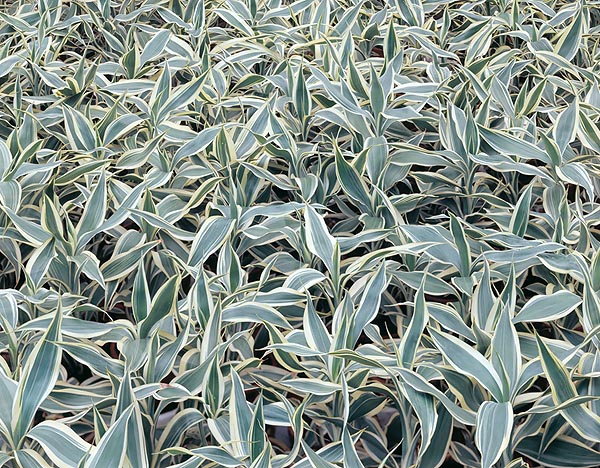Family : Asparagaceae

Text © Pietro Puccio

English translation by Mario Beltramini

A bed of Dracaena sanderiana ready for sale © Giuseppe Mazza
The Dracaena sanderiana hort. Sander ex Mast. (1893) is native to the pluvial forests of tropical Africa (Cameroon and Gabon).
The name of the genus comes from the Greek “drakàina”, which is the female of dragon; the species is honoured to the famous German collector and nurseryman Henry Frederick Conrad Sander (1847-1920), who operated in England and in Belgium.
Common names: “Chinese water bamboo”, “Belgian evergreen”, “friendship bamboo”, “lucky-bamboo”, “ribbon dracaena”, “ribbon plant”, “ribbonplant”, “water bamboo” (English); “bamboo d’eau”, “bambou porte-bonheur”, “canne chinoise”, “canne de Chine”, “dracaena de Chine” (French); “bambú de la suerte”, “dracena de Camerún”, “dracena sanderiana”, “lucky bamboo”, “lucky bambu” (Spanish); “gllücksbambus”, “Panaschierter Drachenbaum” (German); “bambuo-da-sorte”, “lucky bamboo” (Portuguese).
Evergreen plant with thin stems, of about 15 mm of diameter, woody, erect, tall up to 1,5-2m, of a long lasting green colour, which present on the apexes tufts of lance-shaped leaves, rather spaced between them and bent, long up to about 25 cm and 4-6 cm broad, of a full glossy green colour or with a showy yellow or cream white stripe on the edges. The inflorescences are terminal, small and erect, and carry yellowish flowers which are later on followed by small orange globose berries containing 1-3 seeds. It easily propagates by portions of stem.
Plant cultivated for ornamental purposes, particularly in the varieties with variegated leaves, in the tropical and humid subtropical areas in preferably shaded positions; the cultivation can be tried in sheltered location in the warm temperate zones, even if the leaves can get damaged already with temperatures close to 0 °C.
It can be cultivated in pot for indoor decoration in the classical way, but during these last years this plant has been, and is still now, at the centre of an ample commercial and custom phenomenon, thanks also to its resistance to not very favourable local conditions, in which are utilized parts of stem of different height, upright or artificially bent, united in compositions of varied shape and plunged in containers full of water, where they are able to root and produce small tufts of leaves, which can last for long time, provided the water is periodically renewed and they are in a luminous location.
Synonyms: Dracaena braunii Engl. (1892); Pleomele braunii (Engl.) N.E.Br. (1914); Pleomele sanderiana (Sander) N.E.Br. (1914).
→ To appreciate the biodiversity within the ASPARAGACEAE family please click here.
